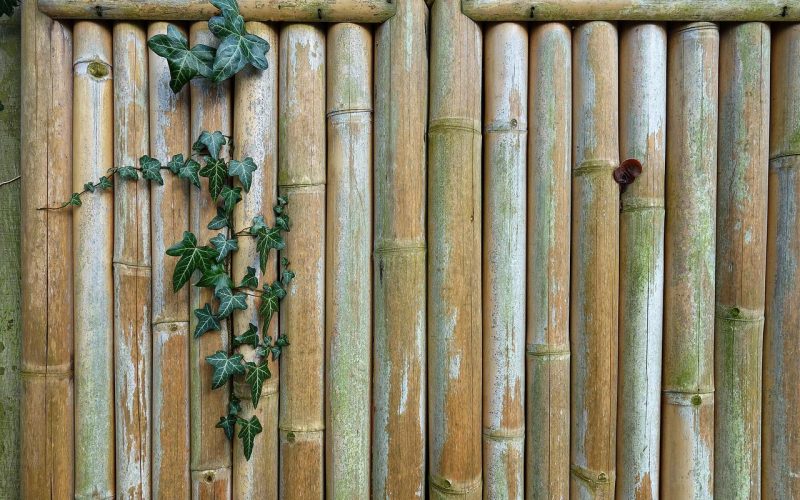Do you like a natural, earthy feel in the exterior or interior of your property and outdoor decor? Are you drawn to the unique look of natural materials and how they can enhance your home or business space?
Whether you’re looking for an island aesthetic, a tiki theme, or a unique and stylish fencing option with a natural touch, bamboo in bamboo fencing is a material that can add a tropical flair or an earthy touch when incorporated into a property or home design.
Bamboo is one of the oldest environmentally friendly materials widely used for fencing. As a plant, bamboo is one of the fastest-growing varieties and one of the largest members of the grass family.
The compressive strength of bamboo is greater than that of wood, brick, or concrete and even offers tensile strength that rivals steel.
The demand for wood is growing rapidly worldwide, even though the supply of wood is increasingly limited.
Due to its strength and woody characteristics, bamboo is widely used instead of wood and other materials commonly used in construction and related works.
Bamboo has several unique advantages, such as growing quickly with high yields because it matures quickly. Also, it can be produced in abundance at a lower cost, which makes it more economical. It is durable; that is, it lasts a long time.
According to ‘Mark Johanson [351] (editor of the book Black & Decker: The Complete Outdoor Builder), bamboo is grass but has many properties similar to wood.
It can be shaped, drilled, and improvised with wood-like finishes, as well as exterior paints and sealants on bamboo structures.
Also, like wood, bamboo tends to split, although it retains much of its strength even when exposed to large cracks and splits.
Generally, bamboo poles in larger diameters (between 5 and 12.5 inches) are more prone to cracking than smaller cans.
Bamboo is a renewable, versatile, lightweight material with the highest strength in its class.
That is why it is widely used in various forms of construction, especially for houses in rural areas.
It is also used to make mats, baskets, tools, handles, hats, traditional toys, musical instruments, furniture, etc.
Additionally, it is used for house components, including pillars, roofs, walls, beams, floors, trellises, and bamboo fencing.
Whether you are installing indoor bamboo fencing on the walls of your building, yard, around your patio or garden, your outdoor restaurant or bar, or any other environment, bamboo will add a refreshing ambiance, an all-natural alluring vibe, and a sustainable element to your property.
One of the many uses of bamboo is to make a strong, well-defined property fence. Here in this article, we will discuss the nitty-gritty of bamboo fencing.
What is Bamboo Fencing?
A fence is a structure that defines the boundaries of a property or space through posts, wires, rails, and barrier panels.
As the name suggests, bamboo fencing is a fence constructed with bamboo. It can also be called bamboo screening.
Bamboo fencing generally comes in eight-foot-long panels of same-sized canes with quality wire or hemp cords.
Panels are rolled up for easy transport and can be used as padding inside a new wooden frame or attached directly to an existing wood or metal fence.
Building a Bamboo Fencing
Bamboo is a rapidly renewable material suitable for fencing if used correctly. To minimize external rot, you can use green bamboo or processed bamboo that is clean, dry, and treated with boric acid.
One of the easiest and cheapest ways to build your bamboo fence is to use a rolled-up one; you can roll it out and tie it to a support structure.
The structure could be your trees or your raised poles. The rolled bamboo is strung with galvanized wires; they are flexible and can easily bend in corners.
Prefabricated bamboo fence panels should be installed with posts and secured like wooden ones. This usually requires at least two people.
Although bamboo is relatively rot-resistant, it doesn’t last as long when in contact with the ground, so you don’t want to bury or cement it into the ground as you would for a cedar post.
If you bury the bamboo poles in the ground, apply a layer of driveway tar sealant to the part you want to bury.
When working with bamboo, the first thing to remember is to pre-drill the holes, do not force a nail or screw through the bamboo poles; it can cause it to split, and also make sure to use galvanized wire if possible to tie and secure the bamboo poles at the joints.
If holes are needed, you can bore them with a keyhole saw attached to a drill. These saws are handy for projects like this and come with different saw blades and diameters.
First, put the drill bit into the pilot hole, which is drilled to prevent the bamboo from splitting, and slowly increase the power. Be sure to drill to the end of the post.
Care and Maintenance of Bamboo Fencing
Fences tend to be outdoors and are subject to wind, rain, Ultraviolet rays, dust, pests, and debris.
The constant cycle of moisture retention and drying can create small cracks in the surface of the bamboo.
UV radiation from sunlight can cause the fibers to deteriorate, and the winds can also blast dust particles across the bamboo surface.
If not adequately maintained, these will eventually cause significant damage and wear and tear to the bamboo fence.
Like any other type of fence, bamboo fencing should also require minor maintenance with the right amount of simple care.
With enough of this maintenance, it should promise a long, satisfying life of aesthetic enhancement and natural style.
Fortunately, you can do three main things to maintain and extend the life of your bamboo fence: protect, clean, and seal it with stains.
Check in every few months for damage and pests; look for cracks, peeling, mildew, holes, insects, pests, or excessive wear.
Detecting and fixing even small problems quickly can prevent water damage, ultimately costing you more.
Insect nests can be a potential problem for bamboo maintenance. Call an exterminator if you see signs of termite infestation.
If any rough edges or pieces of bamboo are on the fence, these should be removed, especially if you have pets or children likely to play around the fence.
You may also need to check for problem niches that must be treated with herbicides, pesticides, or fungicides to make your fence resistant to damage.
Help to prevent mold and rot by cleaning your bamboo fencing once or twice a year, usually just before you seal it.
You can use an environmentally friendly fence cleaner or a solution of three parts water and one part bleach in a garden sprayer.
You may want to pre-wash your fence to remove particularly stubborn dirt.
Finally, sealing your bamboo fence will prevent water seepage and add a layer of protection. If you just washed the fence, let it dry completely before applying the sealer.
After all, you don’t want to seal the water in! Good-quality sealants should be highly moisture—and UV-resistant and contain a water-repellent preservative, fungicide, and stabilizer to reduce shrinkage and swelling.
Longevity of Bamboo Fence
Longevity depends on how your bamboo fence is installed and maintained and on the environmental conditions in which it is placed.
Natural, untreated bamboo will begin to rot in 2-7 years, even under ideal conditions, while adequately treated and cared for bamboo can last up to 20 years.
Prolonged exposure to moist and wet conditions will cause mold and accelerate rotting and decay.
For this reason, many manufacturers recommend that the bamboo fence not be in contact with the ground.
When installing, leave a few centimeters of free space at the bottom of the fence so it does not touch the ground.
With all of this in mind, you know it’s worth taking the time to care for your new fence. And if you’re thinking of buying a bamboo fence, this is great news!
The Strength of a Bamboo Fence
Bamboo is an extremely strong yet extremely light and porous material. It has a higher tensile strength than steel!
Bamboo will resist breaking under loads of up to 28,000 pounds, compared to 23,000 pounds for steel.
Compared to wood, bamboo is two to three times stronger than most woods.
Unfortunately, raw bamboo is slightly less durable than most hardwoods. Bamboo is not a tree; instead, it is a type of grass with woody stems.
Bamboo stalks are tough and fibrous but contain no natural toxins that help prevent biodegradation (or rot).
In addition, bamboo contains a large number of natural sugars, which attract mold, mildew, and pests.
For these reasons, bamboo must be treated with boric acid before being made into fencing or other building materials.
The bamboo manufacturer or grower usually does this treatment.
However, when this is done, the bamboo is much more resistant to some things that will degrade it.
Advantages of Bamboo Fencing
If you’re considering installing a privacy fence but aren’t sure you want to spend the money on a wooden fence and a contractor to install it, a bamboo fence may be a good option.
This attractive fence is less expensive, environmentally friendly, and easy to install. You can choose the easiest fence to install and the height and style best suit your landscaping goals.
Installing a bamboo fence has the following advantages:
Bamboo is Cheap
Bamboo fences cost less than other fences, such as wooden fences, brick walls, etc. Unlike hardwood fences, bamboo fences are pretty inexpensive.
Fence posts or rolls are affordable, and because they are easy to install, installing a bamboo fence can be a DIY project.
The overall cost of your project will be determined by the amount of fencing you need, the style and color of bamboo you choose, and the height of the fence you decide to install.
Bamboo is Environmentally Friendly
An essential quality of bamboo is its respect for the environment, unlike hardwood, which is often an unsustainable building material.
It takes many years to grow a single tree for every tree cut. Bamboo is not a tree but grass that grows quite quickly.
This makes it an environmentally friendly construction product, as replacing what is used in each construction project is easy.
Bamboo grows quickly and is a viable option for home improvement projects.
When you buy an eco-friendly bamboo fence, you choose to help the planet while beautifying your property.
It also has a waxy surface that does not require painting. There is no need to use pesticides and other chemicals when growing bamboo, which makes it more environmentally friendly.
You can install a lovely, attractive privacy fence and feel good about your purchase simultaneously, and it doesn’t get much better than that.
Bamboo Fence Is Easy To Install
When you decide to install bamboo fencing, you choose a product that is easy to install., versatile, and easy to maintain.
It is enough for periodic maintenance to preserve their appearance and durability.
Homeowners with limited skills can install this fence as individual posts or rolls.
A fence doesn’t require a posthole digger, many helpers, or a skilled contractor; most homeowners can install the fencing themselves during the weekend.
Bamboo is Available in a Variety of Colors and Styles
Bamboo fences are also available in various styles, colors, and heights.
Bamboo is the perfect choice whether you are looking for a short fence to delineate your garden beds or a taller fence to provide privacy around your pool or lawn.
Choose between dark black or rich honey color or natural bamboo. You can also decide if you prefer whole bamboo sticks or split bamboo, allowing you to customize your look further.
Bamboo Fencing Gives You Privacy
The proper design of the bamboo screen ensures the beauty of your home.
It also offers security and privacy while emphasizing your home’s elegant and green character seen from the street or the garden.
Bamboo fencing is an easy way to provide privacy for your yard, pool, or hot tub.
It is attractive, easy to install, and costs a fraction of a hardwood privacy fence.
High bamboo poles are placed close to each other, blocking the view of neighbors or anyone passing the sidewalk.
You’ll be pleasantly surprised at how wonderfully a bamboo fence blocks off areas of your yard that you want to keep private.
Disadvantages of Bamboo Fences
Despite all these advantages, bamboo as a fencing material can have disadvantages.
A Bamboo Fence Has a Shorter Lifespan
Fungi and insects often attack bamboo. For this reason, untreated bamboo is considered a temporary fencing option with an expected lifespan of fewer than five years.
Bamboo Fences Are Not Fire-resistant
They ignite very quickly, and the cost of treatment is relatively high.
Bamboo Fences Cannot Be Nailed
Bamboo cannot be nailed in almost all cases. Therefore, most fence joints are made of wire or hemp rope.
Summary of Bamboo Fencing
Bamboo has many valuable features and can last decades if properly cared for.
Bamboo fences come in various colors and styles and provide plenty of privacy to any fenced area.
It can withstand many weather conditions, such as strong winds, heavy rains, and high temperatures.
Environmentally conscious people will love the durability of bamboo. Bamboo stalks are ready to harvest 3-6 years after planting, compared to the 30-50 years the tree needs to grow before harvesting.
Bamboo plants return 30% more oxygen to the atmosphere than other plants and help prevent soil erosion.
However, bamboo is a 100% renewable, green, environmentally friendly, and widely available alternative building material.
Bamboo has proven to be a suitable alternative to wood due to its rapid growth, adaptability to most climatic conditions, low maintenance costs, and similar properties.
Bamboo offers a unique decorative quality that can be used to create an attractive fence. Bamboo fences are available in different shapes, heights, rolls, and panels.
Moreover, you can do it yourself and enjoy your beautiful eco-friendly bamboo fence at an affordable price!
So, if you are considering new or replacement fencing, you should consider bamboo as an option!








